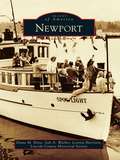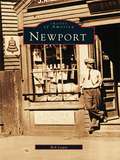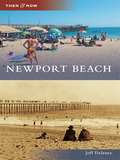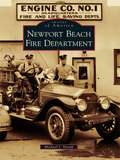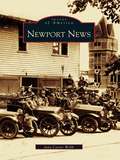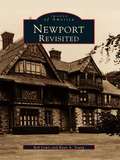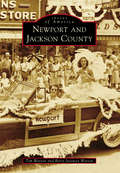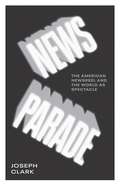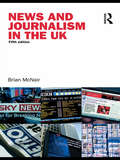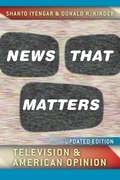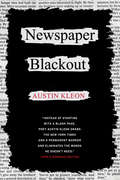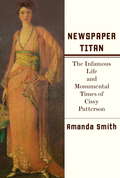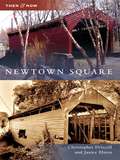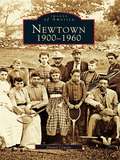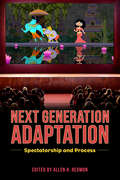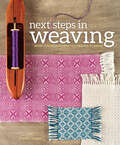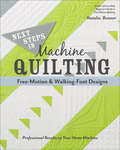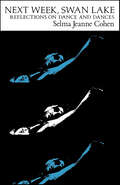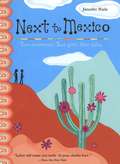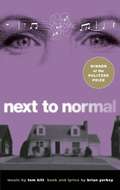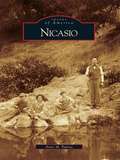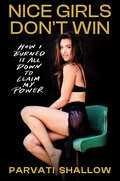- Table View
- List View
Newport
by Lincoln County Historical Society Jodi Weeber Diane Disse Loretta HarrisonNewport and its surrounding areas are beautiful and bountiful, offering resources for fishing, logging, shipping, and tourism. Today's community, similar to populations that settled the land in earlier days, is independent, hearty, and versatile. The Yacona, the Native Americans who called Newport home before the arrival of other cultures, lived almost entirely off the land and waterways. Later settlers, while still reliant on natural resources, integrated technology into the growth of their society. As the area matured, the desire to find balance and preserve natural resources grew. Today Newport's heritage remains strong, and this book serves as a tribute to its history.
Newport (Images of America)
by Rob LewisFounded in 1639, the city of Newport offered a temperate climate and a wealth of natural resources to early settlers seeking religious freedom. In Colonial times, Newport flourished as one of New England's largest seaports, a prosperity dimmed only by the Revolutionary War and subsequent three-year British occupation. Despite the fact that more than one-third of existing homes in Newport were destroyed by the British during their stay, Newport today still has the largest number of eighteenth-century homes of all cities in the United States. In 1968, the Newport RestorationFoundation was founded by tobacco heiress Doris Duke to preserve, protect, and restore the city's eighteenth and nineteenth-century architecture. The foundation's extensive photographic archives have been made available to area resident and modern-day photographer Rob Lewis in the creation of this new and exciting photographic history.
Newport Beach
by Jeff DelaneyNewport Beach, with its picturesque harbor and 10 miles of sandy beaches, has seen great change since its beginnings in the post-Civil War era. Originally a shipping port, it evolved into a haven for movie stars, rumrunners, and gamblers and finally transformed into today's exclusive beach community and popular vacation destination. In his third book on Newport Beach, author and longtime resident Jeff Delaney opens a door between Newport's past and what remains.
Newport Beach Fire Department (Images of America)
by Michael J. NovakFor nearly a century, the men and women of the Newport Beach Fire Department have served their Orange County community with dedication, professionalism, and grace. Starting with a primitive hose reel and a dozen volunteers in 1911, determined Newport Beach firefighters protected the always tourism-friendly community with more dedication than equipment. In 1927, the volunteers were disbanded and a paid fire department was organized. This volume celebrates 100 years of the Newport Beach Fire Department's exemplary service by combining historical photographs with a narrative that traces the evolution of firefighting in Newport Beach from its turn-of-the-century roots to the state-of-the-art operation it is today, entrusted with protecting one of coastal California's most affluent and picturesque showcase communities.
Newport Firsts: A Hundred Claims to Fame (RI)
by Brian M. StinsonNewport, Rhode Island, has been a city of innovation since its beginning nearly four centuries ago. Some of the claims on a national level are true, while some have been greatly distorted over the years. The freethinking citizens include the first to defeat a British squadron and the author of the first written constitution guaranteeing the right to religious freedom in world history. The first law banning the importation of slaves in the colonies was enacted in the city, and the first Methodist church in the world with a steeple and bell is located here. But was the first female lighthouse keeper in America from here? Was Newport the first place where a medical lecture was given? Author and research historian Brian M. Stinson offers a chronological collection of vignettes detailing the city's many firsts.
Newport News
by Jane Carter WebbWithin slightly more than 100 years, the sleepy village of Newport News has transformed itself from a sparsely populated region of watermen and farmers to a city known as one of the nation's greatest centers for shipbuilding, scientific research, Virginia history, and scenic sites. Nestled along the eastern coast of Virginia on the James River, Newport News has a colorful and dynamic history intrinsically linked to the surrounding water. As the town filled with people of great energy and enthusiasm, their hard work propelled local industry to the forefront of the city's reputation.
Newport Revisited
by Rob Lewis Ryan A. YoungIn the three-hundred-fifty-plus years that Newport has existed, it has held a fascination for those who love the sea. Along its narrow streets are nestled the largest collection of preserved eighteenth-century and nineteenth-century dwellings in America. The sailing is spectacular, and the natural harbor is a safe haven for boats. Newport Revisited uses vintage photographs to explore Newport from the 1880s to the 1960s. The book takes the reader on a historic tour to see what people from all parts of the world travel to get a taste of, such as the amazing mansions and the natural beauty of this unique town. Newport Revisited shows the reader the Colony House, Brick Market, and many other exciting sites.
Newport and Jackson County (Images of America)
by Tim Watson Betsy Jacoway WatsonFor almost 200 years, Jackson County has been a typical farming community in the Mississippi Delta. Based on timber, cotton, and freshwater pearls, its early economy produced great wealth for a small group of landowners. In the 1920s, Jackson County was the 10th-largest cotton producer in the country. However, with the arrival of the tractor in the 1950s and the departure of the laboring classes, the county's economy spiraled downward. The tensions in this social mix led to a creative fermentation that allowed Jackson County to become one of the birthplaces of rock and roll. Images of America: Newport and Jackson County tells many of the colorful stories of the history of the county, from land barons and sharecroppers to Elvis, illuminating the rich heritage of its apparently simple towns and communities.
News Parade: The American Newsreel and the World as Spectacle
by Joseph ClarkA fascinating look at the United States&’ conflicted relationship with news and the media, through the lens of the newsreel When weekly newsreels launched in the early twentieth century, they offered the U.S. public the first weekly record of events that symbolized &“indisputable evidence&” of the news. In News Parade, Joseph Clark examines the history of the newsreel and how it changed the way Americans saw the world. He combines an examination of the newsreel&’s methods of production, distribution, and reception with an analysis of its representational strategies to understand the newsreel&’s place in the history of twentieth-century American culture and film history.Clark focuses on the sound newsreel of the 1930s and 1940s, arguing that it represents a crucial moment in the development of a spectacular society where media representations of reality became more fully integrated into commodity culture. Using several case studies, including the newsreel&’s coverage of Charles Lindbergh&’s transatlantic flight and the Sino–Japanese War, News Parade shows how news film transformed the relationship between its audience and current events, as well as the social and political consequences of these changes. It pays particular attention to how discourses of race and gender worked together with the rhetoric of speed, mobility, and authority to establish the power and privilege of newsreel spectatorship.In the age of fake news and the profound changes to journalism brought on by the internet, News Parade demonstrates how new technologies and media reshaped the American public&’s relationship with the news in the 1930s—a history that can help us to better understand the transformations happening today.
News and Journalism in the UK
by Brian McNairNews and Journalism in the UK is an accessible and comprehensive introduction to the political, economic and regulatory environments of press and broadcast journalism in Britain and Northern Ireland. Surveying the industry in a period of radical economic and technological change, Brian McNair examines the main trends in journalistic media in the last two decades and assesses the challenges and future of the industry in the new millennium. Integrating both academic and journalistic perspectives on journalism, topics addressed in this revised and updated edition include: the rise of online journalism and the impact of blogging on mainstream journalism the emergence of 24 hour news channels in the UK the role and impact of journalism, with reference to issues such as democracy, health scares and the war on terror trends in media ownership and editorial allegiances 'Tabloidisation', Americanisation and the supposed 'dumbing down' of journalistic standards the implications of devolution for regional journalists.
News that Matters: Television and American Opinion, Updated Edition
by Shanto Iyengar Donald R. KinderAlmost twenty-five years ago, Shanto Iyengar and Donald R. Kinder first documented a series of sophisticated and innovative experiments that unobtrusively altered the order and emphasis of news stories in selected television broadcasts. Their resulting book News That Matters, now hailed as a classic by scholars of political science and public opinion alike, is here updated for the twenty-first century, with a new preface and epilogue by the authors. Backed by careful analysis of public opinion surveys, the authors show how, despite changing American politics, those issues that receive extended coverage in the national news become more important to viewers, while those that are ignored lose credibility. Moreover, those issues that are prominent in the news stream continue to loom more heavily as criteria for evaluating the president and for choosing between political candidates. “News That Matters does matter, because it demonstrates conclusively that television newscasts powerfully affect opinion. . . . All that follows, whether it supports, modifies, or challenges their conclusions, will have to begin here. ”—The Public Interest
Newspaper Blackout
by Austin KleonPoet and cartoonist Austin Kleon has discovered a new way to read between the lines. Armed with a daily newspaper and a permanent marker, he constructs through deconstruction--eliminating the words he doesn't need to create a new art form: Newspaper Blackout poetry. Highly original, Kleon's verse ranges from provocative to lighthearted, and from moving to hysterically funny, and undoubtedly entertaining. The latest creations in a long history of "found art," Newspaper Blackout will challenge you to find new meaning in the familiar and inspiration from the mundane.Newspaper Blackout contains original poems by Austin Kleon, as well as submissions from readers of Kleon's popular online blog and a handy appendix on how to create your own blackout poetry.
Newspaper Titan: The Infamous Life and Monumental Times of Cissy Patterson
by Amanda SmithThe galvanizing story of Eleanor Medill (Cissy) Patterson, celebrated debutante and socialte, scion of the Chicago Tribune empire, and the twentieth century's first woman editor in chief and publisher of a major metropolitan daily newspaper, the Washington Times-Herald. She was called the most powerful woman in America, surpassing Eleanor Roosevelt, Bess Truman, Clare Boothe Luce, and Dorothy Schiff.Cissy Patterson was from old Republican stock. Her grandfather was Joseph Medill, firebrand abolitionist, mayor of Chicago, editor in chief and principal owner of the Chicago Tribune, and one of the founders of the Republican Party who delivered the crucial Ohio delegation to Abraham Lincoln at the convention of 1860.Cissy Patterson's brother, Joe Medill Patterson, started the New York Daily News.Her pedigree notwithstanding, Cissy Patterson came to publishing shortly before her forty-ninth birthday, in 1930, with almost no practical journalistic or editorial experience and a life out of the pages of Edith Wharton (or more likely the other way around: shades of Cissy are everywhere in the Countess Olenska). Amanda Smith writes that in the summer of 1930, Cissy Patterson, educated at the turn of the century at Miss Porter's School in Farmington, Connecticut, for a vocation of marriage and motherhood and a place in society, took over William Randolph Hearst's foundering Washington Herald and began to learn what others believed she could never grasp--how to run and build up a newspaper. She vividly lived out the Medill family's editorial motto (at least in spirit): "When you grandmother gets raped, put it on the front page."Patterson soon bought from Hearst the Herald's evening sister paper, the Washington Times, merged the two, and became editor, publisher, and sole proprietor of a big-city newspaper, a position almost unprecedented in American history. The effect of the merger was "electric"...By 1945, the Washington Times-Herald, with ten daily editions, was clearing an annual profit of more than $1 million.Amanda Smith, in this huge, fascinating biography gives us the (infamous) life and monumental times of Cissy Patterson, scourge of liberals, advocate of appeasing Hitler, lover of poodles, and hater of FDR.Here is her twentieth-century Washington: its politics and society, scandals and feuds, and at the center--the fierce newspaper wars that consumed and drove the country's press titans, as Patterson took the Washington Times-Herald from a chronic tail-ender in circulation and advertising, ranked fifth in the town, and made it into the most widely read round-the-clock daily in the national's capital, deemed by many to be "the damndest newspaper to ever hit the streets."
Newtown Square
by Christopher Driscoll Janice ElstonNewtown Township, more commonly known today as Newtown Square, is the oldest township in Delaware County, Pennsylvania. While Newtown was mostly farmland until the mid-20th century, it has developed significantly since World War II. Over 100 historic homes and buildings remain along Newtown's four-lane highways, country roads, and neighborhoods. Newtown Square provides a glimpse at the township's changes from rolling countryside to continually growing suburb.
Newtown: 1900-1960
by Daniel CrusonNewtown changed most dramatically in the period from 1900 to 1960, and Newtown: 1900-1960 captures these changes photographically to show how Newtown became the suburban town with a small-town atmosphere that it is today. The book includes an outstanding array of photographs from three recently discovered collections, including a series on the army maneuvers of 1912, which shows the state of the American army before World War I. Newtown: 1900-1960 begins with the village, which is truly the heart of the town. It focuses on institutions such as the Newtown Savings Bank, which was the business center for almost a century and a half. The book then examines the industrial section of town, Sandy Hook, with businesses that both sustained life and just made life more pleasant. In addition, the book looks at the outlying settlements of Stevenson, Hattertown, Hawleyville, and Riverside, a summer colony that became a year-round place.
Next Generation Adaptation: Spectatorship and Process
by Allen H. RedmonContributions by Zoe Bursztajn-Illingworth, Marc DiPaolo, Emine Akkülah Doğan, Caroline Eades, Noelle Hedgcock, Tina Olsin Lent, Rashmila Maiti, Allen H. Redmon, Jack Ryan, Larry T. Shillock, Richard Vela, and Geoffrey Wilson In Next Generation Adaptation: Spectatorship and Process, editor Allen H. Redmon brings together eleven essays from a range of voices in adaptation studies. This anthology explores the political and ethical contexts of specific adaptations and, by extension, the act of adaptation itself. Grounded in questions of gender, genre, and race, these investigations focus on the ways attention to these categories renegotiates the rules of power, privilege, and principle that shape the contexts that seemingly produce and reproduce them. Contributors to the volume examine such adaptations as Quentin Tarantino’s Death Proof, Jacques Tourneur’s Out of the Past, Taylor Sheridan’s Sicario and Sicario: Day of the Soldado, Jean-Jacques Annaud’s Wolf Totem, Spike Lee’s He’s Got Game, and Jim Jarmusch’s Paterson. Each chapter considers the expansive dialogue adaptations accelerate when they realize their capacity to bring together two or more texts, two or more peoples, two or more ideologies without allowing one expression to erase another. Building on the growing trends in adaptation studies, these essays explore the ways filmic texts experienced as adaptations highlight ethical or political concerns and argue that spectators are empowered to explore implications being raised by the adaptations.
Next Level Screenwriting: Insights, Ideas and Inspiration for the Intermediate Screenwriter
by David Landau David CarrenNext Level Screenwriting is an intermediate screenwriting book, for those that have already learned the basics of screenwriting, written a screenplay or two and want to bring their writing and stories to the next level. Each chapter of the book examines a specific aspect of screenwriting, such as character, dialogue and theme, and then provides the reader with ideas, tips and inspiration to apply to their own writing. Rather than being another “how to” book, this volume features a variety of case studies and challenging exercises throughout – derived from a broad selection of successful feature films and TV shows from the 1940s to the present day – to help spark the imagination of the writer as they work through different styles and approaches of screenwriting.An absolute must-read for any screenwriter wanting to improve their writing and storytelling skills.
Next Steps In Weaving: What You Never Knew You Needed to Know
by Pattie GraverThere is a lot to learn about weaving! As a new weaver, you might wonder what the next steps are to grow your skills. Next Steps in Weaving has the answers you're looking for.In this beautiful book by Pattie Graver, former Managing Editor of Handwoven magazine, you'll be explore a variety of weave structures and concepts in depth and detail including twill, color-and-weave, overshot, summer and winter, and lace.This is not just a book of weaving patterns. Each topic is explained and supplemented with instructions for weaving a sampler and a project in order to solidify the concepts and enable you to design your own projects. In addition, the book offers troubleshooting tips in order to expand your weaving expertise.Whether you're new to weaving, have the basics down, or are looking to improve your foundation skills, this book will be an asset to your weaving library. So what are you waiting for? Take the Next Steps in Weaving!
Next Steps in Machine Quilting: Free-Motion & Walking-Foot Designs
by Natalia Bonner50 new modern, sophisticated designs that encourage free-motion quilters of all skill levels to stretch their skills on a home sewing machine.Free-motion fans, rejoice! Natalia Bonner is back with a follow-up to her wildly successful first book that boasts 50 new modern, sophisticated designs that encourage quilters of all skill levels to stretch their skills on a home sewing machine. A variety of simpler straight-line and free-motion motifs invite beginners to dive in, while designs that modernize more traditional patterns will challenge intermediate and advanced sewists. Full-size patterns can be used for practice or marking quilt tops, and tips on a wide range of topics—supplies, embellishments, layering, and basting—open up a world of endless variations.• 50 new modern, sophisticated designs challenge quilters of all skill levels to stretch their skills• Full-size patterns for more elaborate designs can be used for practice or to mark quilt tops• Tips on supplies, layering, basting, and adjusting machine tension
Next Stop Grand Central
by Maira KalmanAt Grand Central Station, Chief of Police George Coppola finds lost people, and Mr. Chidchester, head of the Lost and Found, finds lost dogs. Marino Marino makes oyster stew, while thinking up interesting math problems. A man in a porkpie hat buys cherry pies. Maira Kalman's stylized artwork, along with entertaining text, brilliantly captures the excitement of Grand Central Station, "the busiest, fastest, biggest place there is."
Next Week, Swan Lake: Reflections on Dance and Dances
by Selma Jeanne CohenAn important book of essays on “dance and ideas about dance”
Next to Mexico
by Jennifer NailsWhen Lylice found out she was skipping fifth grade, she was excited. Then nervous. Then excited again. Then terrified. On her first day of sixth grade everything bad that could happen did. But when Senora Schwartz assigned her to be Mexico Mendoza's English Buddy, school got a little better. Then a lot better. Then not as better. Then much, much worse.This is the story of her first quarter at Susan B. Anthony Middle School. And it's the story of how to get away with something that grownups will first not like, then, after they think about it, won't mind. And will actually think was a good idea. Oh, and it's about doing something so stupid because of a boy and worrying that your best friend will ever talk to you again.
Next to Normal
by Tom Kitt Brian YorkeyWinner of the 2010 Pulitzer Prize for Drama"Rock is alive and rolling like thunder in Next to Normal. It's the best musical of the season by a mile...an emotional powerhouse with a fire in its soul and a wicked wit that burns just as fiercely."-Rolling Stone"No show on Broadway right now makes as a direct grab for the heart-or wrings it as thoroughly-as Next to Normal does. . . . [It] focuses squarely on the pain that cripples the members of a suburban family, and never for a minute does it let you escape the anguish at the core of their lives. Next to Normal does not, in other words, qualify as your standard feel-good musical. Instead this portrait of a manic-depressive mother and the people she loves and damages is something much more: a feel-everything musical, which asks you, with operatic force, to discover the liberation in knowing where it hurts."-Ben Brantley, The New York TimesWinner of three 2009 Tony Awards, including Best Original Score (Music and/or Lyrics) Written for the Theatre, Next to Normal is also available in an original cast recording. It was named Best Musical of the Season by Rolling Stone, The Washington Post, Los Angeles Times, and The New York Times.Brian Yorkey received the 2009 Tony Award for Best Original Score for his work on Next to Normal and was also nominated for Best Book of a Musical. His other credits include Making Tracks and Time After Time.Tom Kitt received two 2009 Tony Awards for Best Original Score and Best Orchestrations for Next to Normal. He also composed the music for High Fidelity and From Up Here. His string arrangements appear on the new Green Day album 21st Century Breakdown, and he is the leader of the Tom Kitt Band.
Nicasio (Images of America)
by Anne M. PapinaSituated in the geographic center of Marin County, Nicasio was home to the Coast Miwok village of Echatamal and likely named for a Tamal Indian and alcalde, Guequistabal, who was baptized as Nicasio at Mission Dolores in 1802. As European settlers arrived, many established themselves as dairy ranchers and timbermen. Soon a town square began to take shape, complete with a merchandise store, a butcher shop, two saloons, a racetrack, a livery stable, a Catholic church, and a luxurious three-story hotel. These pioneers aspired to make Nicasio the county seat, a bid that was ultimately lost by a single vote in 1863. The land reserved for civic buildings was repurposed as a baseball diamond, which at one time hosted semipro games and continues to serve local little leaguers. The Rancho Nicasio now stands in place of the hotel, yet the town otherwise appears untarnished by time. Not surprisingly, a number of residents have roots tracing back to Nicasio's founders, with newcomers drawn to its pastoral charm and a lifestyle in deep contrast to that of nearby San Francisco.
Nice Girls Don't Win: How I Burned It All Down to Claim My Power
by Parvati Shallow&“A bible for badass women.&”—SARAH MICHELLE GELLAR&“Gripping and liberating.&”—ADAM GRANT, #1 New York Times bestselling author of Hidden Potential and Think Again&“Survivor legend and gay icon, Parvati Shallow has won my heart all over again.&”—BOWEN YANGA bold, eye-opening memoir about survival, trauma, and healing, from one of reality television&’s most talked-about starsAt twenty-five years old, Parvati Shallow was plunged into fame and fortune after becoming the million-dollar winner of the reality television series Survivor. But despite her success, the ghosts of her traumatic past, coupled with the harsh glare of the public eye, kept her locked in a survival cycle of fear and shame that sabotaged her self-confidence and eroded her self-trust. It wasn&’t until a series of painful life events, including the death of her younger brother and a challenging divorce, that she found herself on a path of healing that would awaken her true power and reset the course of her life.In Nice Girls Don&’t Win, Shallow shares the stories that allowed her to transform her most difficult moments into potent catalysts for empowerment. From her childhood growing up in a Florida commune run by a tyrannical female guru, to her journey out of the South and into the L.A. casting rooms that would eventually drop her in the lush but brutal landscapes of Survivor, Shallow shows readers what it took to build herself into the ultimate survivor—for better and, more often, for worse. She then reveals what it took to rebuild herself into something much greater.As harrowing as it is healing, Parvati Shallow&’s story is a testament to the profound lessons that can be found in radical self-acceptance and self-love.
